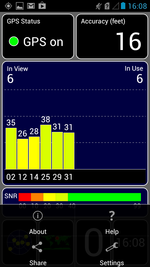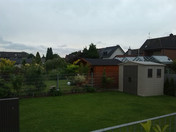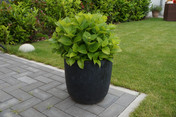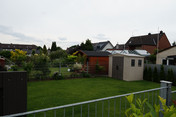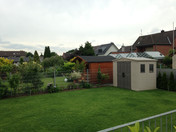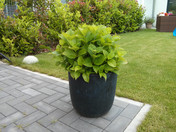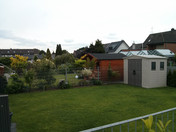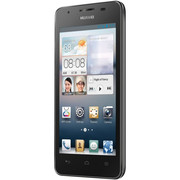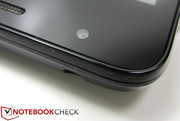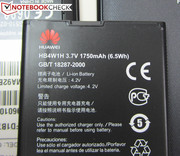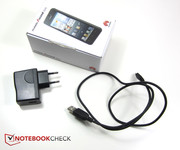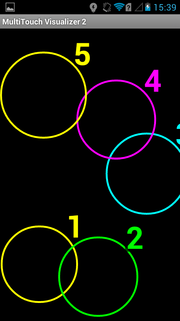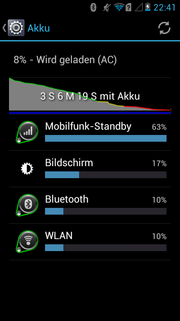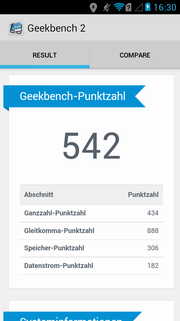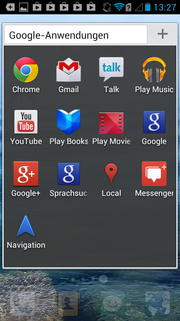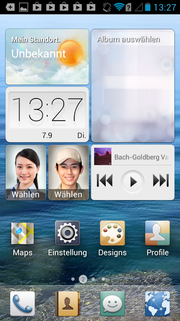Review Huawei Ascend G510 Smartphone

For the original German review, see here.
Huawei makes compelling promises for its Ascend G510. The manufacturer touts the 4.5-inch smartphone as a "multi-talent with wow effect" on its German website. Although the street price of around 160 Euros (~$209) at the time of writing rather indicates a budget configuration in terms of soft- and hardware, the G510 wants to deliver an equally outstanding quality for movies, music and games as well as high performance. As if that wasn't enough, the manufacturer states that the G510 also convinces with an "extra portion" of battery runtime and its 5 megapixel camera can shoot high-quality pictures.
The Ascend's actual hardware does not let us expect A-one performance but rouses hopes for a solid performance. Qualcomm's Snapdragon S4 MSM8225 clocks in Huawei's smartphone with 1.2 GHz. It is mostly found in entry-level devices. It is supported by Qualcomm's integrated Adreno 203 graphics chip. The Ascend G510's software configuration does not give any reason for complaint from the outset. It is powered by Android 4.1 Jelly Bean, which is a current version of the popular smartphone OS. Our test reveals whether the entry-level device fares as good as the manufacturer avows in practical use.
Case
Considering the price, it is no surprise that Huawei uses a low-budget plastic bezel for its Ascend 510. Nevertheless, it keeps the smartphone's front and back firmly together. The casing features a high-quality build, closes seamlessly with the 4.5-inch LC display and no flaws are visible. However, the feel is not all over perfect. The ribbed surface on the casing's back does not give the fingers an especially good grip and the phone can quite easily slip out of the hand.
A removable 6.5 watt hour battery, SIM card slot and another slot for micro SD cards is found behind the casing's back. The back also sports the 5 megapixel primary camera that has a maximum resolution of 2592x1944 pixels. The front-facing 0.3 megapixel camera only manages VGA quality with 640x480 pixels.
The size of 9.9 x 65 x 134 millimeters and a weight of 150 grams do not distinguish Huawei's Ascend G510 from other smartphones with the same screen size. Examples are Huawei's 4.5-inch Ascend G600 or Sony's 4.3-inch Xperia L. Huawei offers the Ascend G510 with a black and white casing. Both cost the same and feature the same equipment, apart from their color.
Connectivity
As said in the intro, Huawei's Ascend G510 is powered by a dual-core Snapdragon S4 MSM8225 SoC, which is frequently found in entry-level smartphones and which stands for a solid performance. According to the chip's manufacturer, the CPU can clock with up to 1.5 GHz. The Ascend G510 remains behind its possibilities because its maximum clock is only 1.2 GHz. Qualcomm's Adreno 203 serves as the graphics chip and supplies enough performance reserves for the current generation of smartphone games.
Huawei made cutbacks in the Ascend G510 storage configuration. The review sample can only store a maximum of 4 GB of data. However, the OS, firmware and preinstalled software use up 3 GB of the system storage and thus only a scanty 1 GB is left for personal data and apps. That makes buying a micro SD card, with which the storage capacity can be expanded by another 32 GB, a must. It is inserted in the micro SD slot underneath the casing's back.
Software
Huawei's Ascend G510 relies on the Android 4.1 Jelly Bean operating system. The OS on the smartphone comes alongside a few preinstalled applications, particularly numerous Google apps like Chrome, Gmail, Google+, Play Store and YouTube. Huawei additionally installs its new graphical user interface dubbed Emotion UI 1.0. It is to facilitate the Android device's operation and managing apps.
Communication & GPS
Besides all common 3G mobile network standards, Huawei's smartphone also supports all four GSM frequencies (850, 900, 1800 and 1900 MHz) and is thus very versatile in terms of communication. Providing that the right SIM card is inserted, it is possible to make calls from virtually anywhere in the world with the review sample. The speech quality is impeccable. The calling parties understood each other very well and interruptions did not occur during the test.
Owing to HSDPA, up to 7.2 Mbit/s is possible in the UMTS network, which is more than sufficient for swift browsing and which keeps waiting times for large downloads within a tolerable frame. Data transfer via HSUPA is performed with up to 5.76 Mbit/s. The Wi-Fi module transmits in the current 802.11 b/g/n standard and convinced with an equally good and stable transmission and reception performance in the test. We cannot complain about the aGPS sensor responsible for navigation and localization either. It quickly found several satellites indoors and provides a pinpoint localization. Besides that, an NFC module is installed. That is rare for this price range, but is at best a nice gimmick with limited usability due to the lack of matching applications.
Cameras & Multimedia
Huawei's Ascend G510 sports two cameras. A 0.3 webcam that only manages a VGA resolution with 640x480 pixels, is on the front. Its quality is at most suitable for video calls and simple snapshots. A lot more can be expected from the 5 megapixel primary camera with up to 2592x1944 pixels on the back, especially since Huawei touts it to be one of the G510's highlights. However, it cannot quite keep this promise. Although the primary camera shoots decent pictures, it cannot compete with the sensors of premium models, such as Apple's iPhone 5 or Nokia's Lumia 920. The objects in pictures look fairly natural but exhibit pale colors and slightly blurred details. A very visible image noise develops quickly indoors.
Accessories & Warranty
The Ascend G510 does not come with generous accessories. Besides the smartphone, only a modular power supply and micro-USB cord are found in the box. Although Huawei does not offer any product-specific accessories for the review sample in its webshop, there are universal products like in-ear headphones or a car charger. The warranty period is valid for 24 months.
Input Devices and Controls
Inputting via the glass surface of the capacitive touchscreen proved to be smooth and allowed using up to five fingers at the same time. Even the three soft touch buttons responded quickly and reliably in every tested application. However, slight delays may occur after booting when icons are tapped right after the home screen appears. Sometimes short waiting times are caused before the selected app is opened because the G510 is still busy with loading some settings in the background.
The 4.5-inch screen particularly allows comfortable use of the virtual keyboard in landscape mode. However, the automatic screen rotation sometimes needs quite a long time and the G510 also uses a QWERTY rather than QWERTZ layout for the onscreen keyboard in the browser even in German language settings. The space bar's mapping is convenient in default settings as it does not add a space in the browser. It inserts a ".com" in the address bar and enables entering according URLs faster.
Display
A brilliant performance in terms of screen won't be expected in a low-priced smartphone like the Ascend G510. However, Huawei disproves this. The good rates of its 4.5-inch LC display were convincing in our test labs, in particular the brightness. The Ascend G510 clearly excels over many identically equipped entry-level smartphones with a brightness of 359 cd/m². Huawei's Ascend Y300 (289.8 cd/m²) and Nokia's Lumia 520 (287.1 cd/m²) come closest to the review sample although with quite a difference. The screens in LG's P710 Optimus L7 II (258.0 cd/m²) and Huawei's Ascend G600 (236.3 cd/m²) are much darker.
| |||||||||||||||||||||||||
Brightness Distribution: 88 %
Center on Battery: 367 cd/m²
Contrast: 781:1 (Black: 0.47 cd/m²)
ΔE ColorChecker Calman: 5.2 | ∀{0.5-29.43 Ø4.78}
ΔE Greyscale Calman: 6.72 | ∀{0.09-98 Ø5}
Gamma: 2.66
CCT: 6802 K
In contrast to the above-average brightness, the black value of 0.47 cd/m² is a step back to mediocrity. Nevertheless, the smartphone still manages a good contrast ratio of 781:1. Huawei's Ascend G600 (835:1) and particularly LG's P710 Optimus L7 II (1075:1) score higher here.
Our measurements using the colorimeter and CalMAN software uncovered minor shortcomings in color reproduction. Overall, the deviations from the ideal values of the sRGB color space are within an acceptable range with an average DeltaE of 5.2. However, the objective assessments are not quite in line with the subjective impression of the LC display. The Ascend G510 renders website contents, pictures and games in rich and bright colors. However, the low resolution of 854x480 pixels especially lets pictures and videos look unfocused.
The high brightness of the 4.5-inch screen in Huawei's Ascend G510 would make it perfect for outdoor use, if it wasn't for the reflective surface as found in many other smartphones. However, the restrictions for outdoor use are kept within a fairly tight limit. The screen content only becomes unrecognizable in very intense light and unfavorable viewing angles.
The content remained perfectly legible even in wider viewing angles. The readability of texts was just as unaffected as the color reproduction of pictures from this perspective. Dimmed or inverted areas on the screen were not noticed even in extreme views from the sides and the color reproduction was still undistorted in this case. The screen's reflective surface has the biggest impact on the readability. Its reflection of light could quickly outshine the content completely in wider viewing angles.
Performance
Huawei's smartphone is powered by Qualcomm's Snapdragon S4 MSM8225 SoC, which can fall back on two processor cores clocked with 1.2 GHz each. The dual-core CPU is supported by Qualcomm's integrated Adreno 203 graphics chip and 512 MB of RAM. The Ascend G510 not only places itself in the entry-level category in terms of price, but also in terms of overall performance. However, such classifications are insignificant in normal use because the review sample almost always responded quickly to inputs and its use was smooth.
The Ascend G510 is virtually on a par with smartphones from the same price and performance category in the synthetic benchmarks. Only LG's P710 Optimus L7 II achieves a minor performance advantage on the whole. However, that will unlikely be noticed in routine use.
| AnTuTu v3 - Total Score (sort by value) | |
| Huawei Ascend G510 | |
| LG P710 Optimus L7 II | |
| Huawei Ascend Y300 | |
| Huawei Ascend G600 | |
| NenaMark2 - --- (sort by value) | |
| Huawei Ascend G510 | |
| LG P710 Optimus L7 II | |
| Huawei Ascend Y300 | |
| Huawei Ascend G600 | |
| Geekbench 2 - 32 Bit - Total Score (sort by value) | |
| Huawei Ascend G510 | |
| LG P710 Optimus L7 II | |
| Huawei Ascend Y300 | |
| Huawei Ascend G600 | |
| Smartbench 2012 | |
| Gaming Index (sort by value) | |
| Huawei Ascend G510 | |
| LG P710 Optimus L7 II | |
| Huawei Ascend Y300 | |
| Huawei Ascend G600 | |
| Productivity Index (sort by value) | |
| Huawei Ascend G510 | |
| LG P710 Optimus L7 II | |
| Huawei Ascend Y300 | |
| Huawei Ascend G600 | |
The browser benchmarks look pretty much the same. Huawei's smartphone is virtually on a par with the competition in its direct vicinity. The only exception is Browsermark 2.0, where the Ascend G510 has a distinct lead and clearly outperforms Huawei's Ascend Y300.
| Browsermark - --- (sort by value) | |
| Huawei Ascend G510 | |
| Huawei Ascend Y300 | |
| Huawei Ascend G600 | |
| Nokia Lumia 520 | |
| Google V8 Ver. 7 - Google V8 Ver. 7 Score (sort by value) | |
| Huawei Ascend G510 | |
| LG P710 Optimus L7 II | |
| Huawei Ascend Y300 | |
| Huawei Ascend G600 | |
| Nokia Lumia 520 | |
| Sunspider - 0.9.1 Total Score (sort by value) | |
| Huawei Ascend G510 | |
| LG P710 Optimus L7 II | |
| Huawei Ascend Y300 | |
| Huawei Ascend G600 | |
| Nokia Lumia 520 | |
* ... smaller is better
The Ascend G510 shows a write and read performance that is within the normal range. Again, Huawei's Ascend Y300 is defeated while LG's P710 Optimus L7 II and Huawei's Ascend G600 cope particularly well with random 4 KB write operations.
| AndroBench 3-5 | |
| Sequential Read 256KB (sort by value) | |
| Huawei Ascend G510 | |
| LG P710 Optimus L7 II | |
| Huawei Ascend Y300 | |
| Huawei Ascend G600 | |
| Sequential Write 256KB (sort by value) | |
| Huawei Ascend G510 | |
| LG P710 Optimus L7 II | |
| Huawei Ascend Y300 | |
| Huawei Ascend G600 | |
| Random Read 4KB (sort by value) | |
| Huawei Ascend G510 | |
| LG P710 Optimus L7 II | |
| Huawei Ascend Y300 | |
| Huawei Ascend G600 | |
| Random Write 4KB (sort by value) | |
| Huawei Ascend G510 | |
| LG P710 Optimus L7 II | |
| Huawei Ascend Y300 | |
| Huawei Ascend G600 | |
Games
Games are fun on the Ascend G510, which is primarily due to its big 4.5-inch screen and decent CPU/GPU computing performance. The smartphone renders rather undemanding games like Angry Birds or Zombiewood smoothly on the screen. Minor stutters only sometimes occur in demanding titles like Iron Man 3, Real Racing 3 or Shadowgun: Dead Zone and commands are delayed slightly. However, that does not have a significant impact on the playability.
Emissions
Temperature
With a maximum operating temperature of 39.9 °C, the Ascend G510 is absolutely within an acceptable range in terms of temperature development. The device is much cooler in idle mode and only reached 29.8 °C. The contenders are equally cool. However, LG's P710 Optimus L7 II fares a bit better in a direct comparison with a maximum of 36.1 °C.
(+) The maximum temperature on the upper side is 39.9 °C / 104 F, compared to the average of 35.2 °C / 95 F, ranging from 21.9 to 247 °C for the class Smartphone.
(+) The bottom heats up to a maximum of 36.9 °C / 98 F, compared to the average of 34 °C / 93 F
(+) In idle usage, the average temperature for the upper side is 28.7 °C / 84 F, compared to the device average of 32.9 °C / 91 F.
Speakers
The mono speaker in the Ascend G510 is not a sound miracle, as expected, particularly since it cannot render any audible mids or bass. Although a DTS logo is placed very visibly on the casing's back, virtually no sound improvement is achieved when this multichannel sound system from the music app is used. The sound is a bit richer, but the effect is ultimately miniscule. A difference is only noticed when listening intently.
Energy Management
Power Consumption
The dual-core Snapdragon S4 MSM 8225 SoC is very moderate with the available battery capacity. The smartphone only consumes between 0.3 and 0.8 watts when idling and between 2.6 and 3.0 watts during load. Identically equipped devices are just as energy-efficient, for example LG's P710 Optimus L7 II with a maximum of 3.6 watts or Huawei's Ascend G600 with 2.8 watts.
| Off / Standby | |
| Idle | |
| Load |
|
Key:
min: | |
Battery Runtime
Due to the middling and not in any way extraordinary electric charge of the 1750 mAh battery, the Ascend G510 only places itself in the midfield in battery runtime. The Huawei managed a minimum runtime of 3 hours and 6 minutes when using maximum screen brightness and all wireless technologies on. A common time for this test scenario. The Huawei lasted for 15 hours and 54 minutes in the maximum runtime test using minimum screen brightness and all wireless connections off except for Wi-Fi. Huawei's Ascend Y300 (28 hours, 36 minutes), Huawei's Ascend G600 (21 hours, 12 minutes) and Nokia's Lumia 520 (17 hours and 5 minutes) do a much better job here.
The Wi-Fi test using a screen brightness of 150 cd/m² and script-controlled opening of websites every 40 seconds comes close to real-life use behavior. The Ascend G510 managed 8 hours and 46 minutes here. Again, Huawei's Ascend Y300 (14 hours, 2 minutes), Nokia's Lumia 520 (12 hours, 56 minutes) and Huawei's Ascend G600 (9 hours, 30 minutes) last longer. LG's P710 Optimus L7 II has the shortest runtime with 6 hours and 56 minutes.
Verdict
Huawei does not make promises it cannot keep for its Ascend G510. Despite a budget price of currently 160 Euros (~$209), the entry-level device includes everything that can be expected from a good smartphone. This is the high-quality build, the very big and bright 4.5-inch LC display and numerous communication modules on the hardware side. The review sample also convinces with an overall smooth use and brings Android 4.1 Jelly Bean alongside all important software tools in form of numerous preinstalled apps that are important for an immediate start.
A few compromises have to be made seeing that the Snapdragon S4 MSM8225 in the Ascend G510 is not the strongest dual-core SoC. However, none of them will be very significant. For example, apps may open with a slight delay directly after turning on the phone. It is also possible that the odd stutter is noticed in games with a very high graphic demand. The integrated cameras are definitely not a highlight, although the 5 megapixel primary camera shoots viable pictures.










